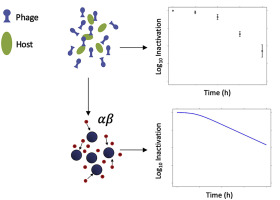当前位置:
X-MOL 学术
›
Water Res.
›
论文详情
Our official English website, www.x-mol.net, welcomes your feedback! (Note: you will need to create a separate account there.)
Modeling bacteriophage-induced inactivation of Escherichia coli utilizing particle aggregation kinetics.
Water Research ( IF 12.8 ) Pub Date : 2019-12-23 , DOI: 10.1016/j.watres.2019.115438 Ethan Hicks 1 , Mark R Wiesner 1 , Claudia K Gunsch 2
Water Research ( IF 12.8 ) Pub Date : 2019-12-23 , DOI: 10.1016/j.watres.2019.115438 Ethan Hicks 1 , Mark R Wiesner 1 , Claudia K Gunsch 2
Affiliation

|
Targeted inactivation of bacteria using bacteriophages has been proposed in applications ranging from bioengineering and biofuel production to medical treatments. The ability to differentiate between desirable and undesirable organisms, such as in targeting filamentous bacteria in activated sludge, is a potential advantage over conventional disinfectants. Like conventional disinfectants, bacteriophages exhibit non-linear concentration-time (Ct) dynamics in achieving bacterial inactivation. However, there is currently no workable model for predicting these observed non-linear inactivation rates. This work considers an approach to predicting bacteriophage-induced inactivation rates by utilizing classical particle aggregation theory. Bacteriophage-bacteria interactions are represented as a two-step process of transport by Brownian motion, differential settling, and shear, followed by attachment. Modifying classical expressions for particle-particle aggregation to include bacterial growth, death, and bacteriophage reproduction, the model was calibrated and validated using literature data. The calibrated model captures much of the observed non-linearity in inactivation rates and reasonably predicts the final host concentration. This model was shown to be most useful in systems more likely to reflect an industrial setting, where the initial multiplicity of infection, or MOI (the ratio of bacteriophage to host organisms), was 1 or greater. For systems of an initial MOI of less than 1 the model showed increased sensitivity to changes in input parameters and a less pronounced ability to reasonably predict inactivation rates.
中文翻译:

利用颗粒聚集动力学对噬菌体诱导的大肠杆菌失活进行建模。
已经提出了使用噬菌体使细菌靶向灭活的应用,其范围从生物工程和生物燃料生产到医学治疗。与常规消毒剂相比,能够区分理想生物和不良生物的能力(例如针对活性污泥中的丝状细菌)具有潜在优势。像常规消毒剂一样,噬菌体在实现细菌灭活方面表现出非线性的浓缩时间(Ct)动态。但是,目前尚没有用于预测这些观察到的非线性失活速率的可行模型。这项工作考虑了一种利用经典粒子聚集理论预测噬菌体诱导的失活速率的方法。噬菌体与细菌的相互作用被表示为布朗运动的两步运输过程,差异沉降和剪切,然后进行附着。修改了经典的表达方式,包括细菌的生长,死亡和噬菌体的繁殖,对模型进行了校准,并使用文献数据对其进行了验证。校准后的模型捕获了许多观察到的失活率非线性,并合理地预测了最终宿主浓度。该模型在最有可能反映工业环境的系统中被证明是最有用的,在该环境中,最初的感染复数或MOI(噬菌体与宿主生物的比率)为1或更大。对于初始MOI小于1的系统,模型显示出对输入参数变化的敏感性增加,而合理地预测失活率的能力较弱。修改粒子-粒子聚集的经典表达式以包括细菌生长,死亡和噬菌体繁殖,使用文献数据对模型进行校准和验证。校准后的模型捕获了许多观察到的失活率非线性,并合理地预测了最终宿主浓度。该模型在最有可能反映工业环境的系统中被证明是最有用的,在该环境中,最初的感染复数或MOI(噬菌体与宿主生物的比率)为1或更大。对于初始MOI小于1的系统,模型显示出对输入参数变化的敏感性增加,而合理地预测失活率的能力较弱。修改粒子-粒子聚集的经典表达式以包括细菌生长,死亡和噬菌体繁殖,使用文献数据对模型进行校准和验证。校准后的模型捕获了许多观察到的失活率非线性,并合理地预测了最终宿主浓度。该模型在最有可能反映工业环境的系统中被证明是最有用的,在该环境中,最初的感染复数或MOI(噬菌体与宿主生物的比率)为1或更大。对于初始MOI小于1的系统,模型显示出对输入参数变化的敏感性增加,而合理地预测失活率的能力较弱。使用文献数据对模型进行校准和验证。校准后的模型捕获了许多观察到的失活率非线性,并合理地预测了最终宿主浓度。该模型在最有可能反映工业环境的系统中被证明是最有用的,在该环境中,最初的感染复数或MOI(噬菌体与宿主生物的比率)为1或更大。对于初始MOI小于1的系统,模型显示出对输入参数变化的敏感性增加,而合理地预测失活率的能力较弱。使用文献数据对模型进行校准和验证。校准后的模型捕获了许多观察到的失活率非线性,并合理地预测了最终宿主浓度。该模型在最有可能反映工业环境的系统中被证明是最有用的,在该环境中,最初的感染复数或MOI(噬菌体与宿主生物的比率)为1或更大。对于初始MOI小于1的系统,模型显示出对输入参数变化的敏感性增加,而合理地预测失活率的能力较弱。该模型在最有可能反映工业环境的系统中被证明是最有用的,在该环境中,最初的感染复数或MOI(噬菌体与宿主生物的比率)为1或更大。对于初始MOI小于1的系统,该模型显示出对输入参数变化的敏感性增加,而合理地预测失活率的能力较弱。该模型在最有可能反映工业环境的系统中被证明是最有用的,在该环境中,最初的感染复数或MOI(噬菌体与宿主生物的比率)为1或更大。对于初始MOI小于1的系统,模型显示出对输入参数变化的敏感性增加,而合理地预测失活率的能力较弱。
更新日期:2019-12-23
中文翻译:

利用颗粒聚集动力学对噬菌体诱导的大肠杆菌失活进行建模。
已经提出了使用噬菌体使细菌靶向灭活的应用,其范围从生物工程和生物燃料生产到医学治疗。与常规消毒剂相比,能够区分理想生物和不良生物的能力(例如针对活性污泥中的丝状细菌)具有潜在优势。像常规消毒剂一样,噬菌体在实现细菌灭活方面表现出非线性的浓缩时间(Ct)动态。但是,目前尚没有用于预测这些观察到的非线性失活速率的可行模型。这项工作考虑了一种利用经典粒子聚集理论预测噬菌体诱导的失活速率的方法。噬菌体与细菌的相互作用被表示为布朗运动的两步运输过程,差异沉降和剪切,然后进行附着。修改了经典的表达方式,包括细菌的生长,死亡和噬菌体的繁殖,对模型进行了校准,并使用文献数据对其进行了验证。校准后的模型捕获了许多观察到的失活率非线性,并合理地预测了最终宿主浓度。该模型在最有可能反映工业环境的系统中被证明是最有用的,在该环境中,最初的感染复数或MOI(噬菌体与宿主生物的比率)为1或更大。对于初始MOI小于1的系统,模型显示出对输入参数变化的敏感性增加,而合理地预测失活率的能力较弱。修改粒子-粒子聚集的经典表达式以包括细菌生长,死亡和噬菌体繁殖,使用文献数据对模型进行校准和验证。校准后的模型捕获了许多观察到的失活率非线性,并合理地预测了最终宿主浓度。该模型在最有可能反映工业环境的系统中被证明是最有用的,在该环境中,最初的感染复数或MOI(噬菌体与宿主生物的比率)为1或更大。对于初始MOI小于1的系统,模型显示出对输入参数变化的敏感性增加,而合理地预测失活率的能力较弱。修改粒子-粒子聚集的经典表达式以包括细菌生长,死亡和噬菌体繁殖,使用文献数据对模型进行校准和验证。校准后的模型捕获了许多观察到的失活率非线性,并合理地预测了最终宿主浓度。该模型在最有可能反映工业环境的系统中被证明是最有用的,在该环境中,最初的感染复数或MOI(噬菌体与宿主生物的比率)为1或更大。对于初始MOI小于1的系统,模型显示出对输入参数变化的敏感性增加,而合理地预测失活率的能力较弱。使用文献数据对模型进行校准和验证。校准后的模型捕获了许多观察到的失活率非线性,并合理地预测了最终宿主浓度。该模型在最有可能反映工业环境的系统中被证明是最有用的,在该环境中,最初的感染复数或MOI(噬菌体与宿主生物的比率)为1或更大。对于初始MOI小于1的系统,模型显示出对输入参数变化的敏感性增加,而合理地预测失活率的能力较弱。使用文献数据对模型进行校准和验证。校准后的模型捕获了许多观察到的失活率非线性,并合理地预测了最终宿主浓度。该模型在最有可能反映工业环境的系统中被证明是最有用的,在该环境中,最初的感染复数或MOI(噬菌体与宿主生物的比率)为1或更大。对于初始MOI小于1的系统,模型显示出对输入参数变化的敏感性增加,而合理地预测失活率的能力较弱。该模型在最有可能反映工业环境的系统中被证明是最有用的,在该环境中,最初的感染复数或MOI(噬菌体与宿主生物的比率)为1或更大。对于初始MOI小于1的系统,该模型显示出对输入参数变化的敏感性增加,而合理地预测失活率的能力较弱。该模型在最有可能反映工业环境的系统中被证明是最有用的,在该环境中,最初的感染复数或MOI(噬菌体与宿主生物的比率)为1或更大。对于初始MOI小于1的系统,模型显示出对输入参数变化的敏感性增加,而合理地预测失活率的能力较弱。



























 京公网安备 11010802027423号
京公网安备 11010802027423号